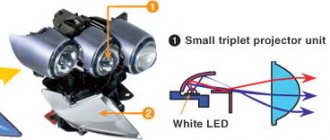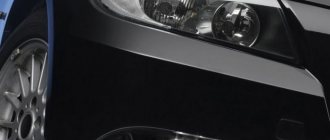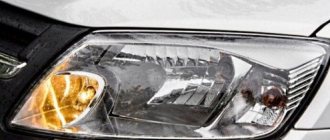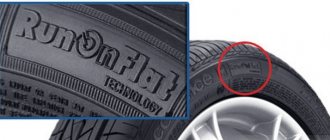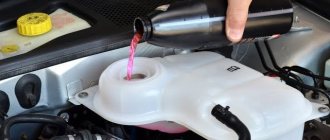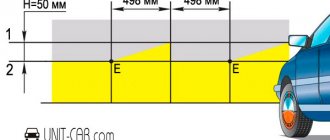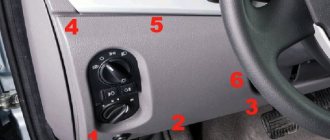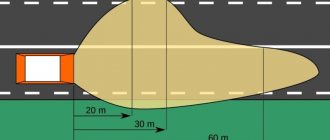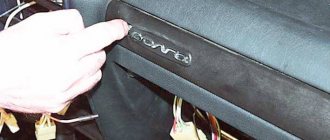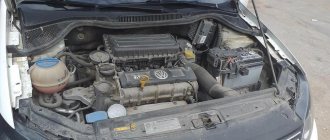Date of publication: September 27, 2021. Category: Automotive equipment.
In connection with the law that appeared in 2010, all owners of automatic telephone exchanges must turn on the light elements on the car not only in the dark, but also during the day. Such requirements are determined solely by the safety of drivers and pedestrians. The fact is that even a barely noticeable light is more noticeable to the human eye than an approaching car.
Such innovations have given rise to many disputes among car enthusiasts. Some people prefer to use low beams, since in this case they won’t have to change anything in the car, while others argue that according to traffic regulations, running lights are the only permissible light sources that can be turned on during the day. Let's try to understand the technical side of this issue first.
Which is better DRL or low beam
If we compare running lights with existing headlights, DRLs have a number of significant advantages:
- When using running lights, you do not need to be constantly connected to a power source, as is the case with conventional headlights. In this regard, by turning on the DRL, you do not have to worry that the battery will be discharged throughout the day, especially if you are often stuck in traffic jams and the generator simply does not have time to recharge the battery.
- Daytime running lights are highly efficient because they shine with a beam of precise direction, while the low-beam headlights provide scattered light.
- Most often, energy-efficient LEDs are used as DRLs, which reduces gasoline consumption by almost 5%. Low beam bulbs require about 35-55 W, and running lights require 5-6 W.
- If the low-beam headlights do not have diode elements, but xenon or halogen ones, they will quickly dry out, since the service life of such elements is from 500 to 4000 hours. LEDs last several times longer - up to 50,000 hours.
- If you install a control unit for running lights, they will turn on and off along with the car engine.
Healthy! If you use side lights during the day, they will simply not be visible.
This is what concerns the technical side of the issue, but there are also strict traffic regulations requirements, which are met only by running lights and fog lights.
DRL connection diagrams
Since DRL can be mounted at your discretion, there are many connection schemes that allow you to configure the optics in the most convenient way for the driver. Let's look at the most popular of them.
Option 1 (to speed sensors)
This connection of running lights through a relay, the diagram of which is shown below, is considered one of the simplest. In this case, the DRLs will turn on depending on the operation of the speed sensor. In order to implement this scheme, it is necessary to connect contacts K1.1 to the circuit section (into the wiring break) from the low beam switch button to contact 85. In this case, you can use any relay with an opening pair, but experts recommend using a product with a TC code.
If you want the dipped lights to work while the engine is on, rather than the side lights, then the contacts must be “paralleled.”
Option 2 (to the oil sensor)
Another scheme for connecting daytime running lights via a relay uses an oil sensor. You should immediately check that it is in good working order, since if the regulator provides incorrect information about the fluid pressure, then the operation of the entire system will be disrupted.
With this installation of DRLs, the lights will turn on when the engine starts, and will be turned off by the dimensions. As optics, you can also use low beam or fog lights.
Option 3
It will be a little more difficult to connect the DRLs so that they turn on when the engine starts and turn off when it stops. In this case, the running lights will turn on together with the low beam headlights. This will require two low-power diodes (for example, 1A + KD10), which must be connected in series. After this, wires about 400 mm long are soldered to the light bulbs and connected. Don't forget that they are polar.
At the next stage:
- Dismantle and disassemble the dashboard of the car and connect the “blank” to X1 (most often the yellow wire).
- Remove the button through which the optics will be turned on.
- Plug the other end of the wire into the connector.
- Reinstall the button and check its functionality.
Option 4 (connecting running lights from the generator)
To implement such a project, you can use one of three schemes.
The first one is suitable if only the handbrake and the engine are used.
The second scheme for connecting running lights from the generator will require the use of an additional resistor, which is responsible for turning off the daylight when the side lights or headlights are activated.
The third scheme will allow you to deactivate the running lights:
- When you raise the handbrake, during the start of the internal combustion engine or during the automatic start of the engine along with the alarm.
- When the lights are turned on (in this case, it is necessary that the headlights or fog lights operate normally).
Roughly speaking, this type of connection “cancels” the automatic start of the DRL simultaneously with the ignition of the generator.
Healthy! It is this scheme that is “working” when passing the GTO.
Before connecting the running lights from the generator, it is recommended to watch the video at the end of the article. The fact is that there is more than one or two ways to activate the DRL. However, the connection will be much easier if you purchased a ready-made set of running lights.
Option 5 (connection of a ready-made kit)
In order not to rack your brains over how to install running lights on a car yourself, the easiest way is to buy a ready-made control unit to automatically turn off and turn on the DRLs. To install this module you need:
- Connect the black wire to the negative of the battery, and the red wire to the positive.
- The orange wire (if included) must be connected to the headlights or low beam. If the wire is not connected, the lights will not deactivate when the low beam or side lights are turned on.
After installing the DRL using any of the schemes described above, it is necessary to check that the installed elements are working correctly. To do this, start the engine and see if the light on the control panel is functioning, if the running lights are activated, and so on.
Traffic regulations requirements for running lights
If there are no daytime running lights on the car, then the car owner will have to pay a fine of 500 rubles. This is clearly stated in Article 12.20 of the Code of Administrative Offenses of the Russian Federation. Therefore, it is not enough to simply install running lights on a car; traffic rules must also be fully observed. So be sure to check out those. CU regulations, which say that:
- DRLs are installed on the front of the car.
- Headlights must be set to a specific white light (yellow running lights or blue-colored light elements are prohibited).
- The distance from the road surface to the lights should be at least 25 cm, but not more than 1.5 meters.
- The distance between running lights must be at least 60 cm.
- There must be at least 400 mm from the edge of the body to the lights if the width of the car is less than 130 cm, in other cases the distance is 60 cm.
If these conditions are met and daytime running lights are installed on the car, you comply with the traffic rules in full. The use of fog lights is also allowed, but their use is not very convenient from the point of view of energy saving.
In addition, the installation of navigation lights according to GOST is considered completed if the lamps shine with a certain intensity, and their number meets certain requirements.
DRL with lenses
Philips with COB and lenses
- model Philips DayLightGuide 12825WLEDX1
- 7 W each;
- luminous flux 875 lm, 125 lumens per watt.
- color temperature 6000K, light slightly bluish, cold;
- service life 5000, not enough;
- power supply 12V;
- dimming, at night the brightness is reduced (muted) and perform a decorative function;
- Philips Luxeon LEDs, probably COB;
- optics in the form of one stretched lens;
- the control unit is compatible with hybrid and electric cars, and the Start-Stop system;
- aluminium case;
- dimensions: 165 x 35 x 23 mm;
- Price about 6,000 rubles.
Probably COB technology is used, when many crystals are placed on one substrate and one long LED in the form of a line is obtained.
The main features of good DRL using lenses
- It is obligatory to have cooling fins at the back, although the technology is used by COB, but heating has not gone away. If there are no ribs, then there is nothing to cool.
- Since the KOB line emits light over the entire surface, optics, such as this Philips, are required. The lens is made in the form of a half circle and runs along the entire body. The COB beam angle is 120 degrees, if there is no good lens, the light will go to the sides.
- Energy consumption cannot be determined visually, or even guessed. Here you have to rely on the information provided by the store.
- The COB power must be at least 10 W, and the luminous flux must be at least 1000 lm.
Philips reviews are not all good; many complain about the build quality. Due to poor sealing, they begin to fog up and condensation appears, although the stated standard of protection from moisture, dust, and salt. Power supply and control units fail. All this is written on Philips’s own website.
Selecting running lights according to GOST
In addition to the basic requirements, when choosing DRLs, it is necessary to take into account the following characteristics of daytime lights:
- Number of lamps. It is best to give preference to blocks, each of which has 5 LEDs installed. If there are more of them, then you will get not just powerful daytime running lights, but dimensions that will not meet GOST requirements.
- Size and shape of lamps. Today, DRL lamps come in a wide variety of shapes. These can be products equipped with an oblong-shaped cast body, triangular, oval or round spotlights, and so on. The main thing when choosing is to consider how much you can maintain the distance between the lamps themselves and the surface.
- Lamp location. When choosing LED elements, it is better to choose models in which the diodes are located in the center. If they are located on the left or right, then their interchangeability is excluded.
- Lamp type. If desired, you can choose lamps of almost any type as DRLs: halogen, incandescent or LED, but the latter are considered the most profitable.
- Lamp light. Despite the fact that LED lamps are capable of illuminating the road no worse than xenon (in the temperature range from 4,300 to 7,000 Kelvin), preference should be given to models with a color range from 5,000 to 6,000 Kelvin.
- The power of light. Regarding the luminous intensity, there are certain requirements, according to which this indicator must be at least 400 cd.
- Price. The price of DRL lamps is not a fundamental factor when choosing daytime lighting elements. Today there is a large selection of such products from different manufacturers, so even inexpensive running lights can work faithfully. It is much more important to pay attention to the characteristics of the lamps.
- Manufacturer. The best manufacturers of DRLs are Philips, Osram and Hella. Such products fully meet international standards and are distinguished by high performance characteristics. However, it is difficult to say that these are cheap daytime running lights, since their cost starts from 4,500 rubles. But high-quality lamps can be found cheaper. For example, Golden DRL Road models have good consumer reviews. Their cost is from 1,000 rubles per set. True, you can’t buy these cheap running lights in every store.
As already mentioned, it is best to use LED lamps for DRLs, however, not all of them will meet the requirements of GOST.
DRL with reflectors
Philips daytime running lights with reflectors
Let's look at the models that are on the official Philips website. Information about them is provided very sparsely. Philips DayLightGuide 12831WLEDX1:
- 9 W each, power supply 12V;
- luminous flux 1125 Lumens, 125 Lumens per W;
- color temperature 6000K, light slightly bluish, cold;
- service life 5000, not enough;
- 9 pieces Philips Luxeon, own production;
- aluminium case;
- Price about 5,000 rubles.
The main features of good running lights with reflectors:
- The presence of metal radiator fins on the back side means there is something to cool.
- LEDs must be planted deeply, thereby ensuring the required luminous angle of 30 degrees. Otherwise, the light goes to the sides and does not shine forward like a flashlight.
- The power is 9 W because there are 9 diodes installed. The energy consumption of good diodes according to international standards is 0.5 W, 1 W, 3 W. Half-watt ones will be weak, which means they are set to 1 W.
- For the Chinese, it is desirable that there be a minimum of 10 W, and a luminous flux of about 1000 Lumens, and then you will really distinguish yourself on the road.
Types of LED lamps for DRLs
After you have studied the rules for installing running lights on a passenger car, all that remains is to choose the right LED DRL lamps. They are divided into several categories:
- Single lensed (they are also called “eagle eye” or “dragon eye”). They usually fail quickly, and the wiring and aluminum alloy housing do not last even several months. The only exception is the “dragon eyes” from Hella.
- On a rubber band. Such products are also not recommended as DRLs, since they do not have a radiator and aluminum boards, so they can only be installed in the car interior as illumination under the feet. However, such lamps are characterized by good sealing. Trusted and well-known manufacturers do not yet sell such lamps (although they have announced the beginning of the development of such models).
- In plastic cases. Such lamps are covered with plastic “glass”, due to which the LEDs become very hot. Even a company like Philips has not yet been able to solve this problem.
- In glass cases. These are the highest quality running lights, which are covered with real glass combined with aluminum. The characteristics of such lamps are the best, however, the price is considerable.
- In the form of plates on SOV diodes. Despite the interesting configuration, this type of DRL is considered the most useless and absolutely does not meet GOST. The fact is that such lamps lack protection from moisture and dust. You won't find a radiator either. The service life of such elements hardly reaches several months, and the power of the light beam allows them to be used only as a backlight, and even then, not the strongest.
- In foglights (lensed headlights). Very high quality and long-lasting DRLs. These elements have almost everything you need: 10 W LEDs, lensed glass, fasteners and, of course, an aluminum housing.
As you can see, despite a fairly large selection of different LED elements, only a few types are suitable for DRLs: those in glass housings and diodes installed in fog lights.
Experience in implementing headlights on during the day
Thus, in Europe the rule “When you get behind the wheel, turn on the low beams” has existed for a long time (in Finland since the 70s). In most European countries, the decision to turn on or not turn on the low beam within the city is completely left to the discretion and conscience of the driver himself (outside populated areas, BS or DRLs must always be turned on). In addition, the installation of daytime running lights on vehicles not yet equipped with them is mandatory, but on preferential terms. And this suggests that European countries care not only about the safety of their citizens, but also about the size of their wallets. In the CIS countries the situation is somewhat different.
In Russia, to increase road safety, a law obliging drivers to turn on low beams (LS) or DRLs during daylight hours both outside and in the city has existed since 2010 (RF Government Decree No. 316). In Ukraine, it came into force only in April of this year and applies only to the autumn-winter period (from October 1 to May 1) and only when driving outside populated areas.
The result of this decision by the authorities was statistics according to which, according to reports from the Ministry of Internal Affairs, in 2011 the number of accidents in Russia actually decreased by 15%. But this is only one side of the coin. But there is another side...
Rules for installing running lights
Most people want to install them so that they look harmonious with the low and high beam headlights. That's why half of car enthusiasts install them at the same level as their fog lights. If you have running lights with a power of up to 5 watts, then at a low setting they quickly collect dirt and dust and lose luminous flux by 2-3 times. This is especially true on country roads with difficult terrain; the light may not be visible because of this. And in hot weather, hot air near asphalt, whose density is higher, scatters light. If you need them for their intended purpose, to increase the level of safety, then place them between the headlights.
The basic requirements for Russia are specified in GOST R 41.48-2004 and GOST R 41.87-99. Depending on the type of vehicle, installation parameters may vary.
- luminous intensity from 400 to 800 Candelas per DRL;
- The illuminating surface area of each DRL is at least 40 cm², so that powerful small LEDs are not installed.
To measure the light intensity yourself, measure the illumination with a luxmeter on the optical axis from a distance of 1 meter. This way you will get Candelas, not Luxes.
After installing the DRL and connecting, you need to check it in sunny weather from 100 meters. Half of the car enthusiasts, after installing Chinese junk with a power of 2 watts (brighter than the dimensions), take photos at night near the car. They take pictures at night so that there is at least a little light.
About the pros and cons
First, let's talk about the advantages of DRLs. They are largely determined by functional characteristics and quick payback. Here's what you should know:
- The lights have low energy consumption. Here's an example: head lights and side lights require an average of 170 watts , and LED DRLs only 14 watts ;
- Duration of DRL operation. LED lamps can work up to 50 thousand hours;
- Brightness, visibility and safety. Unlike conventional incandescent lamps and more modern gas-discharge lamps, LEDs used to indicate a car during the day cannot blind oncoming drivers or pedestrians;
- DRLs can be installed on any car. And, no less important, the choice of lamps is so wide that the driver can effectively complement the exterior of his vehicle;
- When using daylight, you save fuel and the life of the headlight. Since the use of daylight is mandatory in almost all countries, LEDs have found wide application: they do not consume much energy to operate and can last longer than conventional incandescent lamps.
There is only one minus : the price. There are also low-quality analogues, mainly made in China, to choose from. No-name brands should not be trusted. But some European manufacturers supply high-quality DRLs that shine brightly enough and last a very long time. The price for such lighting is appropriate, but every penny is worth it.
